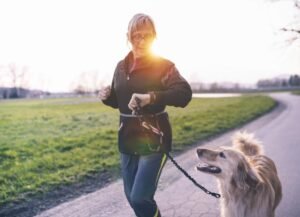Our family dogs are living longer and longer due to advances in veterinary medicine and an elevated level of care by pet parents. And although age itself isn’t a disease, as your pets get older, an extra degree of care is needed. But when is a dog a senior?
When Is a Dog Considered a Senior?
The most widely accepted—and accurate—way to determine when a dog is considered a senior is by their size. In general, the larger the dog, the shorter the dog’s lifespan.
Although it is not fully understood why large dogs don’t live as long as smaller breeds, it’s thought to be because smaller dogs have less stress on their body—particularly their heart. This causes them to live longer and age more slowly. It can also be that some medical conditions dogs develop as they age may be more challenging to treat in larger dogs than in smaller dogs.
Because of this, larger dogs reach their golden years sooner than small breeds. A large dog like a Great Dane may be considered a senior at 6 years old, while a small dog like a Dachshund might not reach senior age until they’re 10. Most dogs are treated as a senior when they’re about 8 years old.
| Small breed (ex. Dachshund) | 10–12 years old |
| Medium breed (ex. Australian Shepherd) | 8–10 years old |
| Large breed (ex. Boxer) | 8–9 years old |
| Giant breed (ex. Great Dane) | 6–7 years old |
Signs That Your Dog Is Becoming a Senior
As a dog ages, both physical and mental changes occur. Here are some common signs your adult dog is entering their senior years.
Cosmetic Changes
Some dogs experience physical changes as they age. For example, a gray muzzle and haircoat are common in dogs as they become seniors. Their skin can also become less elastic, which can delay wound healing and hair regrowth.
A senior dog’s eyes can start to develop a whitish-blue haze to the lens as they age (nuclear sclerosis). This cloudiness can look similar to cataracts, with a very big difference: Cataracts cause vision changes and blindness, while nuclear sclerosis does not affect a dog’s vision at all.
Energy Levels
A senior dog’s energy level is usually dramatically lower than their adult counterparts. A senior dog’s tolerance for playtime and deliberate exercise is less than it may have been when they were younger, and they may sleep longer hours.
Eating and Drinking Habits
Older pups benefit from being on a senior dog diet, which can help prevent weight gain as their activity level decreases.
Senior dogs often have changes to the way they eat, which can manifest as a decrease in appetite, anorexia, or even a ravenous appetite. If your aging dog develops any change in appetite or experiences vomiting, diarrhea, or an increase in thirst, these are signs of an underlying medical condition and should be brought to your vet’s attention.
Mobility Changes
As they age, dogs lose muscle mass and are more likely to gain fat. This can lead to obesity, which causes and exacerbates many health issues, including mobility problems and metabolic diseases such as diabetes.
Arthritis and other conditions that affect a pet’s mobility are more common when your dog is a senior. Even dogs that had orthopedic diseases diagnosed earlier in life (such as luxating patella or ligament tears), might start to have trouble with those joints as other age-related conditions develop.
If your dog starts to limp, drag their feet, or have muscle loss, these could be signs of an orthopedic condition, but it can also be a sign of a neurologic condition such as degenerative myelopathy. Talk to your veterinarian if you notice these symptoms.
Behavioral Changes
Dogs tend to sleep more and lead less-active lives as they age. If your older dog is starting to sleep for longer, especially after exercise they once thrived doing, it’s a sign that your pup is becoming a senior.
Along with increased sleep, many issues common in senior dogs can cause pain and discomfort, leading to physical and mental changes. Changes in appetite, stiffness, difficultly getting up and down or with stairs, anxiety, and aggression are all concerning for a senior dog in pain.
Another condition that causes behavioral changes is canine cognitive dysfunction syndrome (CCD or CDS). CCD is a process similar to dementia and is often compared to early stages of Alzheimer’s disease in humans. This age-related change is due to a dog’s brain deteriorating, which causes changes to their awareness, learning abilities, memory, and overall responsiveness to the outside world.
Sensory Changes
As dogs begin to age into their senior years, their senses are likely affected. Vision, hearing, sense of smell, and taste are all possibilities to be diminished—or even gone completely—in older dogs.
Senior dogs may be hesitant to go outside at night as their vision worsens. They also may not be as responsive to voice commands if they are experiencing hearing loss. If you notice any of these changes in your dog, take them to the vet as soon as possible to develop an appropriate treatment plan.
Senior Dog Care
Caring for your senior dog is not as daunting as you might think, and having the love and companionship of a senior pet can be incredibly rewarding.
Vet Care
One of the most important things you can do to keep your senior dog as happy and healthy as possible is to keep up with routine veterinary visits and preventative care.
Senior dogs should see their veterinarian for checkups every six months. These checkups should include a physical exam, along with blood work and urine testing to evaluate their internal organs—and hopefully to catch any developing disease as early as possible.
Nutrition
Proper nutrition for your senior dog is essential. Switching your dog’s diet to food specially formulated for senior dogs can be beneficial to address any medical issues they might have. It can also help keep them as mobile as possible, as these diets tend to be lower in fat and calories to avoid obesity.
Some of these diets also have the addition of glucosamine and chondroitin supplements, which are great for mobility and joint health. Always speak to your dog’s veterinarian before making changes to your dog’s diet or adding supplements.
Comfort and Pain Management
Another big consideration for senior dogs is ensuring their comfort and addressing any pain they might have. Putting runners on slippery surfaces, such as tile or wood floors, in your home can help your senior dog get traction as they walk.
An orthopedic dog bed is essential for ensuring your senior dog has a soft place to fall asleep while cushioning their joints and decreasing pressure sores. These dog beds are often made of sturdy foam and have washable covers in case of a mess. Some even have a head rest for increased comfort, along with head and neck support for dogs that might have pain.
Even though your senior dog might develop age-related problems, it doesn’t have to stop them from living a happy, healthy, long, and active life. Some dogs might need a little more TLC than others, but a senior dog can be just as involved and cherished in your family as a pet of any age.




